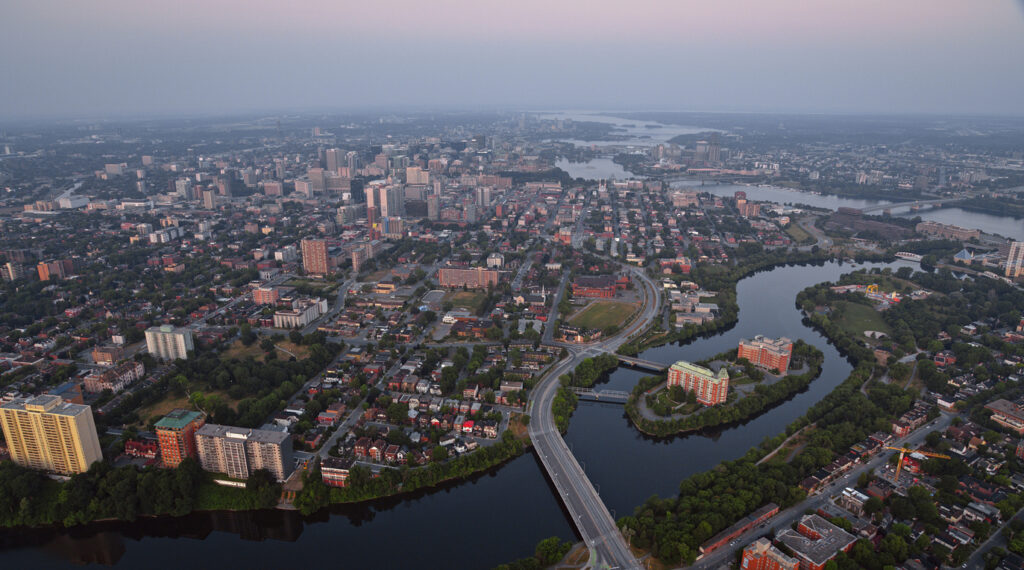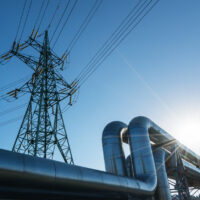On May 3, 2022, the Ontario Energy Board (OEB) did something that observers considered nearly unprecedented in its 62-year history: it turned down an application to build the final stages of a pipeline replacement project proposed by a fossil gas utility, Scarborough-based Enbridge Gas.
The OEB’s Decision and Order on the $123.7-million St. Laurent North project cited the City of Ottawa’s community electrification plan (Energy Evolution) and the option of downsizing the pipeline due to reduced future demand for natural gas among the factors in the decision. According to the city, major drivers of that reduction include Ottawa’s Energy Evolution plan itself, as well as the federal government’s effort to convert its Cliff Street heating and cooling plant to lower-emitting technologies—changes that Enbridge did not factor into its gas demand forecasts.
The decision sent minor shock waves through the province’s energy regulatory and municipal energy communities. “Nobody expected them to lose. Zero expectation,” energy regulatory lawyer Jay Shepherd of Shepherd Rubinstein said at the time.
But “having the City give evidence that everybody is cutting back on their carbon in Ottawa, the OEB was hard pressed,” he added. “When the City goes in and says it won’t be using as much gas anymore, you can’t just ignore it.”
The question for all stakeholders—from Enbridge, to the City of Ottawa, to the various intervenors that took part in the hearing—is whether the OEB decision has application elsewhere. Is the decision an early indicator of how Canada’s energy transition can be expected to play out?
This case study is based on an analysis of the OEB ruling, related literature, and interviews with key stakeholders affected by the decision. Stakeholders are quoted throughout the study to give context and perspective to the analysis.
Utility Planning in a Time of Transition
The Enbridge application and the OEB decision played out at a moment when cities, utilities, regulators, and governments at all levels are working to understand the implications of the race to net-zero emissions—then build that urgent, new planning imperative into their policies, practices, and investments.
These profound, relatively rapid shifts coincide with mounting alarm about the climate impact of fossil gas extraction, transmission, distribution, and use. Proposals for new or renewed gas infrastructure must contend with the rising popularity of heat pumps as a practical option to electrify home heating. And they must also wrestle with the role that clean gases like hydrogen or biogas may, or may not, play.
Against this backdrop, the St. Laurent North application and decision played out at a moment when business-as-usual planning and thinking are still common among gas suppliers and utilities. In turn, that reality may have been driven by an operating model in which gas companies’ return on equity is by law based primarily on the kilometres of pipe they own and operate, rather than the volume of gas they supply.
Some stakeholders say this structure creates a business imperative to expand the gas network regardless of consumer demand, at a pace at least sufficient to offset depreciation of installed assets. A couple of them expressed concern that this model risks leaving ratepayers exposed to stranded asset costs if new or expanded infrastructure is taken out of service prematurely due to emission reduction efforts. Ultimately, there remains uncertainty about who might pay for any potential stranded assets – ratepayers, shareholders or the taxpayer.
Specifics of the Ruling
One of the issues underlying the OEB decision was whether Enbridge had adequately engaged in integrated resource planning (IRP). It suggested that Enbridge “should work collaboratively with the City of Ottawa and other stakeholders to proactively plan a course of action if and when pipeline replacement is required, including the pursuit of Integrated Resource Planning (IRP) alternatives.” It also suggested the utility adopt that same approach for future projects elsewhere in the province to the extent applicable.
The OEB issued its commentary at a time when some stakeholders are calling for gas utilities to coordinate planning more closely and deliberately with electricity distributors in their territories. The OEB set out requirements for local IRPs in a July 22, 2021 decision and order, with one of five screening criteria allowing an exception for gas system needs that had to be resolved within three years. In the St. Laurent North hearing, Enbridge could not convince commissioners that the replacement was too urgent to wait.
The company also refused to consider downsizing the pipeline, citing a consultant’s conclusion that the city couldn’t reduce gas demand enough to justify a smaller pipe. But local officials disagreed, and while the OEB did not address the contention that Ottawa could see reduced demand, the decision was widely interpreted as reinforcing the city’s position.
In the proceeding, city staff “indicated that its preference would be for an integrated energy planning approach that would require the main energy suppliers (gas, electricity, and district energy) to work together to build an energy system which meets the Energy Evolution climate goals while ensuring affordability and energy security,” commissioners Anthony Zlahtic and Emad Elsayed said.

At the time, an Enbridge spokesperson maintained that the rejected Phase 3 and 4 pipeline replacements “are the most prudent alternative to address the known integrity concerns within an ongoing degradation of the St. Laurent pipeline system. This is especially true given the magnitude of consequences to customers and the public in the event of system failure”—a concern that is obviously important, but that the OEB commissioners said Enbridge had failed to establish in this case.
Enbridge’s Five Year Plan
Meanwhile, the focus has shifted from the St. Laurent North decision to the OEB’s hearings on Enbridge’s five-year rate plan. The plan and the OEB’s decision on it will have significant implications for other municipalities across Ontario and their own shift from fossil fuels to non-emitting sources of energy.
The hearings should be an opportunity to emphasize and encourage integrated resource planning and, more broadly, to align the direction of the province’s gas system with larger climate targets and policies. But there is a risk of business-as-usual thinking predominating. For example, stakeholders say Enbridge’s interventions to date assume no new demand-side management (DSM) or energy conservation programs beyond those already in place, and they still schedule the St. Laurent North project for 2024-25, part of a 10-year, $15.3-billion capital plan.
The Enbridge application emphasizes a diversified pathway that centres on maximizing energy efficiency, optimizing and integrating energy system planning, investing in “low-carbon gas”, and using carbon capture, utilization and storage (CCUS) to produce low-carbon hydrogen.
That plan, in turn, is based on a Guidehouse study which acknowledges the momentum for a comprehensive shift to electrification, but ultimately builds a case for a “diversified” scenario in which there is “a “dedicated network of hydrogen pipelines and some gas infrastructure in the province,” and where “gas heating continues to play a key role in building heating, complemented by heat pumps” powered by “low or zero-carbon gas”.
Guidehouse sees its diversified scenario saving ratepayers $181 billion by 2050, largely based on reduced need for electricity infrastructure to meet peak demand. The study remains contentious among stakeholders interviewed for this study.
The lack of consensus around Guidehouse’s recommended scenario reinforces the need for a far more comprehensive analysis of the lowest-carbon, least-cost path available to electricity and gas consumers in Ontario—analysis which could be rooted in large part in the integrated resource planning at the local level that the OEB is now mandating.
Against the likelihood of significant future policy shifts, it will be important to assess not only what the most cost-optimal pathways for infrastructure development and maintenance might be, but also the risk of ratepayers bearing the costs of infrastructure that ends up stranded. “The biggest issue in this plan is going to be the energy transition,” said one stakeholder.
Gas Networks in an Uncertain Future
The shape of the future energy system is still unknown, any transition that uses less gas will take time to unfold, and many analyses see some mid-century demand for gas, if only to serve the end uses that are toughest to shift. So there remains a legitimate need to maintain a viable gas network – especially if that network may in time see a much larger role for biogas or hydrogen.
Enbridge commissioned the Guidehouse study “largely because we feel that emissions reductions have become equated with just electrification,” said Malini Giridhar, Enbridge’s vice-president of business development and regulatory. “There are multiple pathways to getting to lower emissions. We specifically wanted to understand the role and the benefits that gaseous fuels can play in getting us to net zero.”
If that system is overbuilt and gas assets are eventually stranded, however, the risk may yet land on ratepayers, not shareholders. According to one stakeholder, Enbridge’s submissions to the OEB’s five-year rate hearing appear to assume that ratepayers will continue paying for pipeline infrastructure, including new installations, at least through mid-century.
“They’ve said many times that if they build these assets for ratepayers, ratepayers have to pay for them,” he said. “Assets will not be stranded.” The rate hearing may hear arguments that, if Enbridge wants to build new infrastructure, the risk should rest with the company, not with customers who have no effective say in how the utility spends its capital dollars.
One of the strengths in Enbridge’s business model is its ability to offer investors a stable, predictable return as a regulated utility. But a stakeholder said that benefit may not be permanent if there’s a real dispute at the Energy Board as to how the benefits and costs of utility investments should land on ratepayers, as has been the case in other jurisdictions.
“The Energy Board is going to be approving spending on gas pipelines,” another stakeholder said. “They’re not going to require that they be used. The problem with an approval of too much spending on gas pipelines will come to roost down the road. So in many ways it’s a climate issue, but it’s also a really big financial issue.”
Transition Questions
The saga of the St. Laurent North pipeline replacement project is certainly open to more than one conclusion, given the need for some gas in even the most ambitious electrification scenarios and the possibility of clean gases becoming available over the longer term. But it raises a series of larger questions for communities, utilities, and regulators trying to navigate the transition to a net-zero energy system—across Ontario, and across the country.
- What are the options for municipalities that take their climate commitments seriously, and wish to engage in integrated resource planning? “The regulatory arena is not for the faint of heart,” one stakeholder said, and it’s hard enough for cities to advocate effectively for the IRP processes they want when they have resources and qualified technical staff to devote to the issue. The challenge is magnified for communities, including smaller municipalities, that have little or no capacity to conduct independent analysis and make a firm case for whatever decarbonization pathway best aligns with their needs and priorities. One stakeholder pointed to Kingston, Ontario as a community that is better able to control gas distribution because it owns its municipal gas utility.
- What’s the future for gas utilities whose fundamental business model is jeopardized by the imperative to decarbonize, the declining costs of alternatives, and the often ignored potential of behind-the-meter solutions? Stakeholders suggested a company like Enbridge could better prepare itself for a net-zero future by diversifying its business into electricity or heat pumps, or emulating the model emerging in Quebec, where the provincial electricity and gas utilities are attempting to integrate their energy supply and efficiency programs. The main obstacle has to do with business and finance, not technology choices.
- What is the recourse if stakeholders believe a utility has failed to comply with a regulatory mandate? The OEB set a clear expectation for integrated resource planning in 2021 and reinforced it with the St. Laurent North decision in 2022. Some stakeholders said that type of mandate will dictate a more proactive monitoring and enforcement role that may be unfamiliar for an institution like the OEB. Their observations raise important questions about the role of the regulator and whether it has the authority—or, at present, the capacity—to address an essential, emerging issue on the road to a net-zero future. Ontario’s Electrification and Energy Transition Panel has been wrestling with this and a number of other, related questions, and its report later this year is expected to make an important contribution to the discussion.
- What further actions must governments take to demonstrate that they’re serious about decarbonization, to allay stakeholders’ doubts based on past climate commitments? And what can stakeholders do in the meantime? Long-term infrastructure planning is necessarily an exercise in anticipating and assessing contingencies, and until emissions begin to fall, there will be some logical basis for gas utilities to assume they won’t—and yet those utilities’ expansion plans could help make the assumption a dangerous, self-fulfilling prophecy. In a federal-provincial system, the power of legislated net-zero commitments at the national level must be reflected and reciprocated by genuine, ambitious action by provincial governments—often through mandated action via legislation or regulation. But by the time elected officials of all partisan stripes are ready to work across jurisdictions on an integrated response to the climate emergency, it may be too late to get emissions under control. While all stakeholders are entitled to expect policy certainty, there is still a growing opportunity for gas utilities to navigate policy uncertainty in ways that embrace the opportunities available to them in a decarbonized future.
- What is the recourse for ratepayers or others who may face significant stranded asset costs if their gas utility bets on the wrong scenario for future decarbonization? Unless this issue is anticipated and prevented, there is a possibility that it will evolve into a trade-off between two societal challenges—the imperative to decarbonize the entire economy by 2050, and the high future cost to individual households and businesses of infrastructure that, with hindsight, may turn out to be redundant to community needs.


